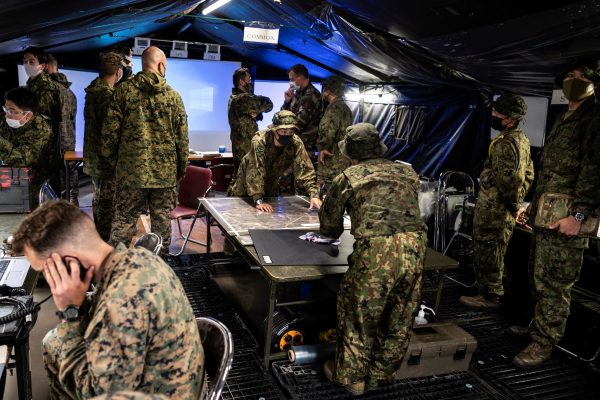A month later, Japanese Prime Minister Yoshihide Suga and US President Joe Biden also called out China for its behaviour, raising concerns about human rights issues, maritime challenges across the region and economic coercion imposed on trading partners. Their statement suggests renewed allied concern about rising tensions there.
Japan will have no choice but to prepare to defend itself in the case of a conflict across the Taiwan Strait. Proximity to Taiwan — only a hundred or so kilometres separate Taiwan from Japan’s southernmost islands — makes the possibility of conflict there of deep interest to Japan’s Self-Defense Forces (SDF). In addition, Okinawa hosts a considerable array of US military forces, making it a likely staging area for any US assistance to Taiwan’s defences.
Japanese Deputy Prime Minister Taro Aso testified to the Diet on 5 July that a military crisis across the Taiwan Strait would threaten Japan’s survival. This was a nod to the 2015 security laws that laid the groundwork for the SDF to join with other national militaries in case of a conflict.
But the consequences of Tokyo’s decision-making on Taiwan will be grave. China remains one of Japan’s largest trading partners and the PLA regularly operate in and through Japan’s waters and airspace.
The regional military balance around Japan has been shifting in China’s favour. The clash between Beijing and Tokyo over a long-dormant sovereignty dispute over islands in the East China Sea a decade ago suggested that China was willing to use its maritime forces, both coast guard and navy, in support of its territorial claims.
Military action by China against Taiwan would provoke the United States into a military response. Many experts argue that China has little to gain from a direct attack on Taiwan. Yet, outgoing Indo-Pacific commander Admiral Philip Davidson told the US Congress that he thought the PLA would be able to launch such an attack within the next six years. A US response to Chinese aggression against Taiwan would be calibrated to the nature of that threat. Chinese pressure on Taiwan could present itself as grey-zone tactics or as cyberattacks. Both could create unprecedented challenges to Taiwan’s economic vitality and territorial integrity.
Regardless of the intensity of such a confrontation, Tokyo would be faced with difficult decisions about how Japanese and US forces would cooperate in response. Japan’s role would likely involve two distinct actions. First, Japan would be asked to provide support for US operations. Second, Japan’s Self-Defense Forces would need to consider how best to defend Japanese territory during a conflict.
Not surprisingly, opinion within Japan is divided. There are those who believe that Japan must play a role with the United States should China use force against Taiwan. Defence ministry officials clearly see a need to develop more clarity on how the alliance would respond.
Minister of Defence Nobuo Kishi’s political deputy, State Minister of Defence Yasuhide Nakayama, has repeatedly declared to the media that it is time to ‘wake up’ regarding Taiwan. The newly released 2021 Defence White Paper — which drew considerable attention for its anime-inspired samurai on the cover — clearly stated that cross-Strait tensions were an important factor in considering Japan’s security.
Political leaders, even those within the Liberal Democratic Party, are unsure of what steps to take next. Prime Minister Suga has taken a more reserved stance than his deputy. Sharing fully US and Japanese assessments of Chinese behaviour across the Taiwan Strait and in the vicinity of Japanese territory is indispensable, but care must be taken to ensure the politics of the moment take a back seat to the need for alliance readiness.
Alliance consultations will move ahead by year’s end, and Japan should be prepared to develop its options in three areas: which bases and facilities would be available to US forces in a Taiwan contingency; what priorities and principles for joint military action would apply; and what would Japan’s Self Defence Forces be require to deliver in joint response to a crisis.
Needless to say, preventing a crisis may be Tokyo’s best approach. In addition to ensuring deterrence against the possibility that China will use force, Japan’s strengths, like those of the United States, lie in a strategy to deter such a crisis. Here, Japan has many options.
A serious strategy of diplomatic coalition building with the aim of ensuring Taiwanese autonomy would go a long way towards signalling Japanese intent. Japan must consider its own demonstration of official support for the government in Taipei and build diplomatic coalitions that similarly acknowledge Taiwan’s need for international support.
Japan may have deep economic ties with China, but that does not preclude enhancing trade and investment ties with Taiwanese firms. Japan–Taiwan trade is about one-tenth that of Japan–China trade, and avenues for growth should be pursued.
The 24 million people who live on the island of Taiwan should have the strength of Japanese support for their democracy and autonomy. Tokyo can speak out openly and without reservation about its shared interests and longstanding friendship with Taipei.
The relationship of Japan’s next generation and their neighbours can be strengthened. The Global Cooperation and Training Framework recently launched by the United States, Japan and Taiwan is an excellent example of the kind of initiative that will ensure the Taiwanese people can continue to look forward to a prosperous and secure future.
Sheila A Smith is Senior Fellow for Asia Pacific Studies at the Council on Foreign Relations.
An extended version of this article appears in the most recent edition of East Asia Forum Quarterly, ‘Confronting crisis in Japan’, Vol 13, No 3.
The ANU’s annual Japan Update conference will be held online 8 September.

